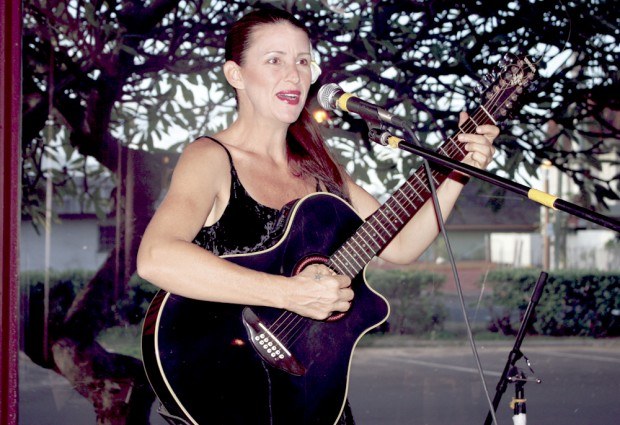She sounds a bit like Joni Mitchell, a bit like Keola Beamer, with maybe even a dash of Ani Difranco thrown in — but Millicent Cummings is more unique than just a combination of other artists. Cummings, an artist of
She sounds a bit like Joni Mitchell, a bit like Keola Beamer, with maybe even a dash of Ani Difranco thrown in — but Millicent Cummings is more unique than just a combination of other artists.
Cummings, an artist of many trades (sculptor, painter, singer, ki ho‘alu player, to name a few), said her first passion in life was dancing, which she started at the age of 4.
But that took a back seat to music when she was 10, as that’s when her father, who played with the Salt Lake City Bluegrass Boys, taught her her first couple of chords.
Following that, Cummings became a songwriter, she said, at the age of 16.
“My songwriting is intended to honor the sacred and the best in the human condition,” she said. “Like how the Hawaiians in their traditional music intended to inspire aloha for each other, for the land and for the children.”
Such ideologies resonate in songs Cummings wrote such as “Moloka‘i Blues” and “Altar Native,” the latter of which Cummings said is about “putting the native back on the altar.”
Another song, “Forbidden Isle,” is what Cummings describes as a social commentary “about our relationship to the land and the inappropriate position the Hawaiians are in (regarding) their own land.”
Following a taro-planting and harvesting visit to Moloka‘i, Cummings wrote “Moloka’i Blues,” after kanikapila (playing music) with other musicians during the trip.
But what Cummings’ lyrics seem to be into these days is the concept of seven generations, especially relevant as she has a 2-year-old son, Maika‘i Pono.
“He is my greatest honor in life,” Cummings said.
Cummings’ song, “7 Generations,” is about the futures of our keiki and ‘aina, she said.
“It’s the children that the Western world has lost the concept of,” Cummings said. “We’re living in an unsustainable paradigm. Any unsustainable way of life is not clearly geared toward honoring the sacred — it’s much more geared toward profit and gain and selfish motives that do not serve the children or the land,” she said.
“So my music is an expression of honoring the sacred like the Hawaiians honor their land and their children and each other.”
It’s with that idea in mind that Cummings said she hopes her music will express, as it’s “aimed at returning to a sustainable way of life for the children — like the Hawaiians had intended their sacred music to be able to achieve and manifest.”
But what really sets Cummings apart from the rest isn’t necessarily her lyrics (she’s written more than 400 songs) but her ability to write originals that pay homage to Hawaiian culture while also conveying a soothing, spiritual, folksy and pun-worthy quality.
“For me it reflects the divinity inherent in all of life,” she said. “Our present world view is not honoring that.” Cummings, who studied at Parsons School of Design as an artist, said the first time she heard Keola Beamer her musical life was changed forever.
“I could hear the slack-key language,” she said, noting “the ‘taro-patch tuning’ broke open a whole world born out of using the Hawaiian open tunings.”
From then on, she was hooked.
“The love of the Hawaiian people and wanting to help to preserve the indigenous culture spoke to me,” she said. “The Hawaiian understanding of the sacred in everything. …hopefully my songwriting will be recognized for that affinity with it.”
Millicent Cummings will be playing Dec. 17 at the Blue Planet inHanapepe.
She’ll also host a costume party from 8 to 11 p.m., Jan. 1, atTrees Lounge; cover is $10.


